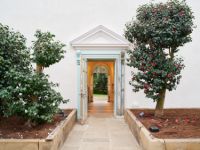Grade II* listed Camellia House opens to the public
28 March 2024

A Grade II* listed building that contains some of the Western world's rarest camellias is open to the public after lying derelict for 50 years.
The Camellia House at Wentworth Woodhouse had been listed on the Historic England ‘Buildings at Risk’ register before the sensitive conservation project which has seen the at-risk heritage building transformed into a tearoom.
We worked alongside architects Donald Insall Associates to provide M&E services for the project. The greenhouse is heated with underfloor heating to provide internal conditions suitable for the protection of the 200-year-old camellias with the secondary benefit of improving comfort for visitors.
Natural ventilation will ensure a constant supply of cooling fresh air in summer and allow humidity control to suit the camellias, and a rainwater harvesting system provides rainwater for watering the camellias naturally rather than the chemically treated mains water.
A ground source heat pump will provide heating to the building for the first time since the original coal fire heating system was decommissioned.
"It is amazing to finally see the Camellia House at Wentworth Woodhouse open again. It really demonstrates what can be achieved with an ambitious client in the Wentworth Woodhouse Preservation Trust with genuinely sustainable values.
The camellias really were the client though. We designed a low carbon ground source heat pump heating system with ground loops in land that ironically was previously an open cast coal mine, to provide a stable environment for the trees (and a bit of comfort for tea drinking patrons), automatic natural ventilation, and rainwater harvesting provides naturally mineralised unchlorinated water for them, all integrated seamlessly into the Grade II* listed fabric by Donald Insall Associates." - Iain Shaw, Director and Manchester Office Leader, Max Fordham
Architects Watson and Pritchett designed the Camellia House in 1812, but its oldest parts date from 1738. It later became home to some of the first camellias to arrive in Britain from China and Japan. After the owners departed in the 1980s, the Camellia House fell into decline, and the camellias became overgrown, reaching through the broken roof. A key challenge for the project was to restore the roof in a way that would not disturb the flowers and help conserve them for the future.
.jpg)